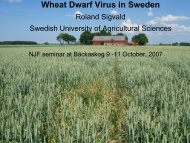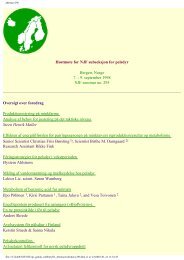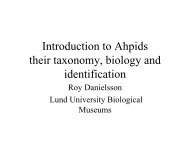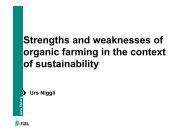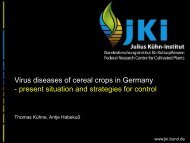measurement methods of soil, water, plant and fruit, in berry ... - NJF
measurement methods of soil, water, plant and fruit, in berry ... - NJF
measurement methods of soil, water, plant and fruit, in berry ... - NJF
Create successful ePaper yourself
Turn your PDF publications into a flip-book with our unique Google optimized e-Paper software.
ESTIMATION OF OPTIMUM HARVEST DATE FOR APPLES<br />
BY MORE PRACTICAL METHOD<br />
Ibrahim Tahir<br />
SLU, Section <strong>of</strong> Top Fruit Production-Kivik<br />
Box 97, 277 21 Kivik-Sweden<br />
ibrahim.tahir@hvf.slu.se<br />
Pick<strong>in</strong>g <strong>fruit</strong>s <strong>in</strong> optimum date, is the best way to carry out high quality <strong>and</strong> m<strong>in</strong>imum losses<br />
dur<strong>in</strong>g storage. However the determ<strong>in</strong>ation <strong>of</strong> this date is cultivar <strong>and</strong> production-area depend,<br />
<strong>and</strong> this situation causes many difficulties at the choos<strong>in</strong>g <strong>of</strong> the accurate ripen<strong>in</strong>g <strong>in</strong>dex.<br />
Various maturity <strong>in</strong>dexes have been used to estimate the last save harvest date for long- term<br />
storage. Many <strong>in</strong>vestigations showed that ethylene production <strong>and</strong> / or respiration rate were<br />
most useful. Accord<strong>in</strong>g to these results, the long <strong>of</strong> safety period can not be shorter than one<br />
week <strong>and</strong> no longer than four weeks. ( Faragher & Brochier 1981, Liu 1978). Whereas<br />
<strong>measurement</strong> <strong>of</strong> ethylene production is not practical for the growers, many other <strong>in</strong>dexes were<br />
used such as : days from full bloom, flesh firmness, soluble solids concentration, starch test,<br />
acidity, color, sk<strong>in</strong> wax <strong>and</strong> ease <strong>of</strong> separation from spurs. The purpose <strong>of</strong> this work is to<br />
exam<strong>in</strong>e the accuracy <strong>of</strong> three practical ripen<strong>in</strong>g <strong>in</strong>dices ( firmness, solid soluble<br />
concentration <strong>and</strong> starch content ) by correlation with storage results <strong>and</strong> ethylene production.<br />
Material <strong>and</strong> <strong>methods</strong><br />
Fifteen trees / cultivar ( Aroma, Cox´s Orange Pipp<strong>in</strong> <strong>and</strong> Ingrid Marie) were mentioned<br />
r<strong>and</strong>omly <strong>in</strong> Kiviks orchard dur<strong>in</strong>g the seasons 1993 – 1997. Fruits were picked ( 12<br />
<strong>fruit</strong>s/tree) early <strong>in</strong> the morn<strong>in</strong>g twice a week, dur<strong>in</strong>g the period between end <strong>of</strong> August <strong>and</strong><br />
end <strong>of</strong> October. At all <strong>of</strong> pick<strong>in</strong>g times, a lot <strong>of</strong> 30 <strong>fruit</strong>s were analyzed <strong>and</strong> 150 <strong>fruit</strong>s hold on<br />
2-3C , 90% RH. After 15 weeks <strong>of</strong> storage, <strong>fruit</strong>s were removed, quality parameters, fungal<br />
decay, <strong>and</strong> disorders controlled.<br />
Analyses:<br />
Flesh firmness by Penetrometer.<br />
Solid soluble concentration by refrectometer.<br />
Ethylene production by gas chromatography.<br />
Ground <strong>and</strong> superficial color by M<strong>in</strong>olta Chromameter CR 200.<br />
Starch content by Iod<strong>in</strong>e –test.<br />
Acidity by titration.<br />
All data were subjected to analysis <strong>of</strong> variance, us<strong>in</strong>g the Micros<strong>of</strong>t Excel 5 spreadsheet.<br />
Results & Discussion<br />
Dur<strong>in</strong>g the five seasons, the flesh firmness <strong>and</strong> starch content <strong>of</strong> the three cultivars <strong>fruit</strong>s<br />
decreased with maturation as well as solid soluble concentration <strong>in</strong>creased. Our results<br />
showed that there was a period <strong>of</strong> <strong>fruit</strong> development, dist<strong>in</strong>guished by very slow changes <strong>in</strong><br />
these ripen<strong>in</strong>g parameters. This period that was 2- 4 weeks long, <strong>in</strong>tervened two<br />
other development’s phases when the changes <strong>in</strong> the same parameters took place <strong>in</strong> higher<br />
rates.<br />
To control our conclusion <strong>in</strong> correlation with storage results, we found that <strong>fruit</strong>s which<br />
picked dur<strong>in</strong>g these weeks had better storability than other <strong>fruit</strong>s. ( Table 1 – 3 ) However,<br />
slow change <strong>in</strong> the three parameters was not always a good <strong>in</strong>dex to predict storability, s<strong>in</strong>ce<br />
we found <strong>fruit</strong>s with slow change that had bad storability <strong>and</strong> also <strong>fruit</strong>s with faster changes<br />
which had good storability. Due to this problem we shortened the period <strong>and</strong> found that




